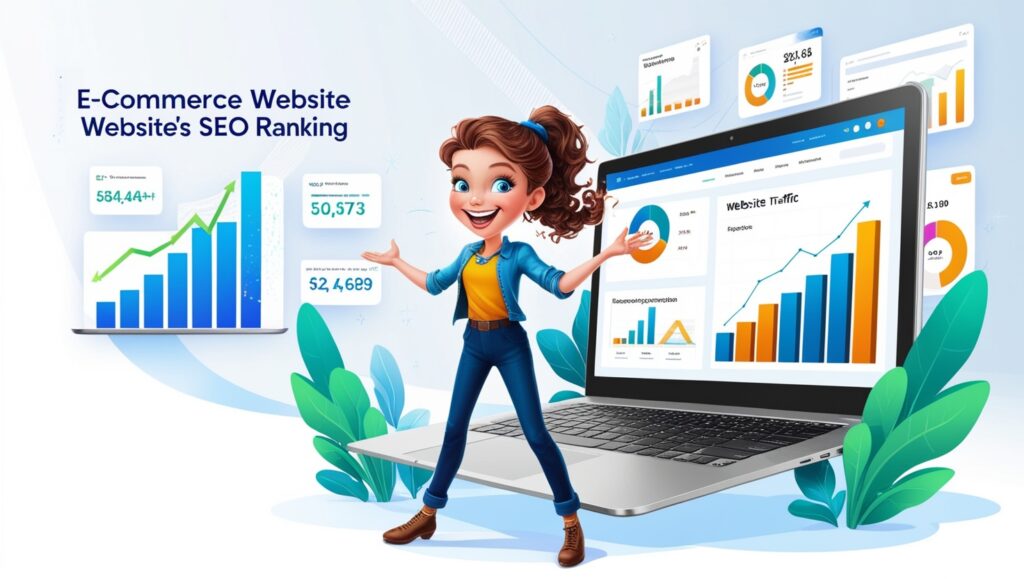How to improve your website visibility by SEO
In the digital age, having a strong online presence is essential for businesses of all types and sizes for a website’s growth. Whether you run a local store or an international e-commerce website, standing out in search engine results can significantly impact your success. SEO, or Search Engine Optimization, is one of the most effective ways to increase your website’s visibility. By understanding and applying SEO best practices, you can bring more visitors to your site, improve the user experience, and ultimately grow your business. Let’s explore why your website needs SEO, what it is, the importance of local SEO, and how you can improve your website’s performance gradually.
Why Your Website Needs SEO?

SEO is essential because it directly influences how easily people can find your website when they search for information, products, or services related to your business. Today’s internet users rely on search engines like Google, Bing, and Yahoo to provide relevant answers to their questions, and search engines use complex algorithms to decide which websites to show first. If your website does not rank highly in search results, potential customers might never even find you.
An optimized website with relevant content and proper keywords can achieve higher rankings, which leads to more traffic. With SEO, you’re not just getting random visitors; you’re attracting people actively searching for what you offer. This relevance means a higher chance of converting these visitors into loyal customers. Moreover, SEO has long-term benefits. Unlike paid ads that disappear once your budget is depleted, SEO can continue to bring traffic to your site over time, making it a cost-effective marketing strategy.
What is SEO?

SEO, or Search Engine Optimization, is the process of enhancing a website to make it more attractive to search engines, with the ultimate goal of improving rankings in search results. There are several key components of SEO:
- On-Page SEO: This involves optimizing individual pages on your website to make them relevant for specific keywords. It includes elements like content quality, keyword placement, headings, image optimization, and meta descriptions.
- Off-Page SEO: This aspect of SEO involves building credibility and authority for your website through external signals. The most well-known off-page SEO tactic is link-building, where other websites link back to your site. The more reputable sites that link to yours, the more trustworthy search engines perceive your site to be.
- Technical SEO: Technical SEO ensures that search engines can crawl and index your website without any issues. It includes optimizing your website’s loading speed, ensuring mobile-friendliness, using HTTPS, and creating a clean site structure.
- Content SEO: Quality content is the backbone of SEO. Content SEO involves creating informative, valuable, and engaging content that satisfies users’ search intent. By focusing on answering users’ questions and providing them with valuable insights, you can improve your website’s authority and relevance.
Each of these components plays a role in improving your website’s visibility, helping you to rank higher on search engines and reach a larger audience.
Importance of Local SEO for Your Website:
Local SEO is a specific branch of SEO that helps businesses optimize their online presence for local search results. If you run a business with a physical location or serve customers in a specific area, local SEO can make a substantial difference. Local SEO strategies focus on optimizing your site to appear in “near me” searches or when users search for services in specific geographic locations.
Here are some ways local SEO can benefit your website:
Increased/Improved Foot Traffic: Many people search for local businesses with the intent of visiting them. By appearing in local search results, you can drive more foot traffic to your business.
– Better Conversion Rates: Local searchers often have high buying intent, making them more likely to convert than general website visitors.
Enhanced reputation: Appearing in local search results can also build trust and credibility. For example, getting positive reviews on your Google My Business listing can improve your reputation in the community.
Competitive Advantage: Local SEO allows smaller businesses to compete with larger brands on a local level. By focusing on local keywords, optimizing for “near me” searches, and keeping an updated Google My Business profile, you can stand out in your local area.
How to Gradually Improve Website Performance Through SEO?

- Conduct Keyword Research: Effective SEO begins with understanding what your potential customers are searching for. Use tools like Google Keyword Planner or Ahrefs to identify relevant keywords with good search volume and relatively low competition. Targeting the right keywords will make it easier for people to find your content.
- Optimize On-Page Elements: Ensure that your website’s on-page elements, such as titles, meta descriptions, headings, and image alt tags, are properly optimized for your target keywords. Keep your titles and descriptions compelling and informative to encourage clicks from search engine results.
- Create High-Quality Content: Consistently produce valuable, informative, and engaging content that aligns with the search intent of your audience. Whether it’s blog posts, product descriptions, or guides, make sure each piece of content is helpful and well-researched. Over time, this will establish your site as a trusted source in your industry.
- Improve Site Speed and Mobile-Friendliness: Google considers both site speed and mobile-friendliness as ranking factors. A slow or poorly optimized website can drive visitors away. Use tools like Google PageSpeed Insights to analyze your website’s speed and fix any issues. Additionally, ensure that your site provides a seamless experience on mobile devices.
- Build Quality Backlinks: Gaining backlinks from authoritative websites is one of the best ways to improve your site’s credibility. Start by creating link-worthy content, such as infographics, case studies, or in-depth guides. You can also reach out to relevant websites in your industry to collaborate on guest posts or link-building opportunities.
- Use Google Analytics and Search Console: Regularly monitor your website’s performance through tools like Google Analytics and Google Search Console. These tools provide valuable insights into how visitors interact with your site, which pages perform well, and which keywords drive traffic. By analyzing this data, you can make data-driven adjustments to your SEO strategy.
- Stay Updated on SEO Trends: SEO is constantly evolving as search engines update their algorithms. Stay informed about the latest SEO trends and changes, and adjust your strategy accordingly. Joining SEO communities or subscribing to reputable SEO blogs can help you keep up-to-date.
By taking these steps and focusing on long-term growth, you can improve your website’s performance and visibility gradually. Remember that SEO requires consistency, patience, and ongoing optimization, but the rewards of increased visibility, traffic, and conversions make it a highly valuable investment.
Conclusion:
SEO is a powerful tool for improving your website’s visibility in search engine results, helping you attract more visitors and increase brand awareness. By focusing on the essentials of SEO—on-page, off-page, technical, and local optimization—you can build a solid foundation for long-term success. Understanding and applying these principles can give you a competitive edge in today’s digital landscape. Start optimizing your site now, and over time, you’ll see a steady improvement in traffic and performance, helping your business grow in the long run.